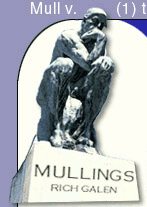|
|

|

Click here to keep up with Galen's Speaking Schedule
Looking for a back issue of Mullings? They're in the
Archives
Sunday in the Park with George. W.
 Wednesday, February 13, 2002
Wednesday, February 13, 2002
Click here for an Easy Print Version
From Juneau, Alaska
Capitol City GOP Lincoln Day Dinner
- The war in Afghanistan has assumed new characteristics. In the early days all of the networks had their maps with lines of who controlled what territory; colors showing where we were; different colors showing where the enemy was; all being explained to us by some guy who could say the phrase "special ops" without sounding like a military groupie.
- Now, however, the enemy has crawled behind the skirts of the very women by whom they are repulsed; hiding, in many cases, in plain sight.
- Stephen Sondheim wrote the lyrics and music for a musical named "Sunday in the Park with George" which was inspired by the art of Georges Seurat, a nineteenth-century pointillist painter, specifically a painting entitled "A Sunday Afternoon on the Island of La Grande Jatte."
- Without getting into a discussion over whether you can write a whole show about one painting by an artist only 17 people have ever heard of (and I was not one of them), there is one song which has classic lyrics, reaching well beyond the subject at hand.
- The song which, was the show stopper, is named: Putting it Together. In it, George describes the process of creating a work of art: Gaining recognition, which leads to getting a commission, allowing you to mount an exhibition, etc. In the song George says, "The art of making art; is: Putting it together."
- The italicized lines are actual lyrics - in their proper order - from that song.
- Bit by bit; putting it together;
- The Pentagon briefing questions, the other day, centered around a recent missile attack from an unmanned surveillance plane on suspected terrorists. The rhythms of the answers by Rear Admiral John Stufflebeem and Tory Clarke sounded very much like Mandy Patinkin and Bernadette Peters who starred the TV production of the play.
- Piece by piece; only when you make a work of art;
- On the question about how we knew these were bad guys if we didn't know their exact identities:
- If you're tracking vehicles coming from different locations that come to a meeting place, and you have some information about the source of those vehicles or who might have been in the vicinity where those vehicles departed from, that is a way you can build a mosaic.
- Every moment makes a contribution; every little detail plays a part;
- Another reporter asked why, if we had advance intelligence on this little convoy, we didn't just send in Special Forces troops or manned aircraft.
- What you're seeing now is an adaptation of the technology. Since you have an armed vehicle which can see this target, which has met the criteria for whomever is controlling that operation to say, "I can strike that target and I have a weapon to bring to bear on it now rather than lose this opportunity."
- Having just the vision's no solution; everything depends on execution;
- Final question: How do you sort it out? How do you know you're not being played off by one warlord against another?
- Because you don't ever rely on one piece of information anymore. If one guy is going to tell you one thing, [you say] "thank you very much. I appreciate having that information." I'm going to go to others. I'm going to try to keep building this thing until I get a mosaic, if I can put it together, and look for other indicators.
- Putting it together. That's what counts.
If you are working at a lobbying firm, a government affairs office, a coalition, or a PAC you should take a
look at this page to see how advertising in Mullings might serve your organization very well:
--END --
Copyright © 2002 Richard A. Galen
Current Issue |
Secret Decoder
Ring | Past
Issues | Email
Rich | Rich
Who?
Copyright �1999 Richard
A. Galen | Site design by Campaign
Solutions. | |
|
